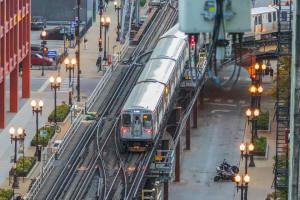Lawmakers grill mass transit leaders as clock ticks toward funding
‘cliff’
[March 01, 2025]
By Ben Szalinski
SPRINGFIELD — Public transportation reform in the Chicago area is at the
top of state lawmakers’ to-do list this spring, but exactly what that
reform will look like remains unclear.
Metra, the Chicago Transit Authority and Pace, along with the Regional
Transportation Authority, which oversees some aspects of the Chicago
area’s transit systems, collectively face a $771 million funding
shortfall in 2026 as federal pandemic dollars run out. That includes
inflation, according to the RTA, which previously said the shortfall
would be $730 million.
Without money to fill that gap, transit users could face up to a 40%
reduction in services, RTA Executive Director Leanne Redden said.
The transit agencies were peppered with questions from lawmakers during
a House hearing this week about their shortfalls in planning,
organization and execution of services. Lawmakers have said for months
the agencies will not receive new state funding without major reforms to
their operations happening first.
In a particularly tense exchange, Rep. Rita Mayfield, D-Waukegan, ripped
into RTA Chair Kirk Dillard.
“I think that we need to blow up the RTA, totally blow it up, get rid of
everyone, because again, systemic incompetence for the last 50 years,”
Mayfield said. “I don’t want to keep anyone other than the janitors and
the basic clerical staff. Anybody in a leadership position needs to be
removed.”
What has been proposed
Various reform plans have been proposed, including some from transit
activists and labor organizations. Dillard is pushing a plan that
focuses on empowering the RTA to coordinate more operations between the
transit agencies.

Current state law limits the power of the RTA to regional planning,
setting standards for the service, developing performance measures,
allocating funding, financial oversight, and capital planning. The three
agencies that actually provide public transportation are left to
determine levels of service, schedules and fares.
“What the RTA’s role is at best is the bully pulpit and trying to
coordinate, convene and have conversations if there is no compelling
mechanism — financial, statutorily or out of penalties — whereby the RTA
can control that outcome,” Redden said.
About 17% of the transit systems’ funding comes from the state,
according to the Chicago Metropolitan Agency for Planning. State law
mandates half of the funding must come from rider fares, though that
requirement has generally been suspended since the pandemic.
Dillard’s plan aims to address some of those areas where transit
agencies are left to make their own decisions. Under his proposal, the
RTA would gain more power to set fares, including on a unified app. The
RTA would also have more control over service coordination and receive
quarterly reports from the three systems that would allow the RTA to
require improvements in exchange for more funding.
Dillard also said the RTA has identified $100 million in “efficiencies”
to provide savings to the agencies.
“We’re not asking just for money,” Dillard said. “We have presented
significant reforms that will be there.”
But Mayfield, who chairs the House appropriations committee that
oversees transportation, questioned why the RTA is needed.
“I for one will never vote to give you more anything, definitely not
more power or more money, because I’ve not seen anything good come out
of the RTA,” Mayfield said.
Other lawmakers said regional oversight remains necessary, but
significant reforms are needed.
“I believe that we need this regional oversight,” Rep. Mary Beth Canty,
D-Arlington Heights, a former RTA board member, said. “My frustration
has always come from a place of us not being able to get that in a
meaningful way.”
Labor unions have proposed their own plan. The AFL-CIO-led plan calls
for more coordination between agencies including universal fare tools,
coordinated safety on public transportation and reducing the percentage
of the agency’s budget that must come from fares.

Sen. Ram Villivalam, D-Chicago, has introduced a bill that would merge
all the transit agencies into one entity known as the Metropolitan
Mobility Authority.
[to top of second column]
|

A CTA Purple Line train rounds a corner of the Chicago “Loop.”
(Capitol News Illinois photo by Andrew Adams)

Challenges toward reform
Achieving reform faces numerous challenges and differing opinions among
transit leaders and lawmakers. It also faces the financial reality that
the state has limited resources to dole out.
Similar-sized transit agencies in other states receive far more state
funding than Chicago’s systems. Pennsylvania funds half of
Philadelphia’s public transit costs while other systems receive at least
a quarter of their funding from the state.
It’s this “chronic underfunding” by Illinois that has made this
shortfall worse, Redden said.
Even among the Chicago-area systems, there’s disagreement about how
funding should be prioritized between agencies. CTA Chief Financial
Officer Tom McKone said the CTA wants a greater share of transit funds
for carrying 86% of the region’s daily riders and to provide more
service. But lawmakers weren’t sold.
“If we can’t take care of what we have already, how the hell are we
going to expand into anything?” Rep. John Cabello, R-Machesney Park,
said. “It just doesn’t make sense. It doesn’t make sense at all. I mean
if we can’t pay for what we have today, how can we expand?”
There’s also disagreement between the agencies about what the governing
structure should look like as some push to consolidate transit
governance.
“This issue, in our opinion, is not from a governance issue,” CTA Acting
President Nora Leerhsen said. “This discussion of consolidation is not
something that we think would solve the issues that we know riders want
to see solved, from CTA’s perspective. Consolidation would bring
additional administrative burdens that would in fact exacerbate some of
the inequities that we’ve seen.”
Consolidation could also cause problems at Metra, CEO Jim Derwinski
said.
“I do believe because we represent six counties, because the RTA taxing
region represents so many communities, an oversight board that can see a
regional perspective is required,” Derwinski said.

Metra is also bound by other agreements, contracts and federal railroad
laws. Many operations that appear to the average rider to be run by
Metra are actually run by freight companies that own Metra’s rail lines.
For example, employees who work on the BNSF Metra line to Aurora are
BNSF employees and the passenger schedules on the Milwaukee District
North and West lines to Fox Lake and Elgin are dictated by Canadian
Pacific, according to Derwinski.
“It almost sounds like, I’m not going to say impossible, but close to
impossible, for you to actually be a part of some big service board,”
Rep. Will Davis, D-Homewood, said.
Logistical questions about a governing structure are only part of the
issue. The other question that must be addressed is how the budget
shortfalls, which RTA officials said will grow beyond $771 million in
subsequent years, will be addressed, particularly as the state faces its
own financial constraints.
Gov. JB Pritzker’s proposed $55.2 billion state budget for the next
fiscal year raises spending by just 1% across most of state government
but doesn’t include any new spending for public transportation.
“Who’s covering how much of that is a negotiation that will take place,”
Pritzker told reporters after his budget address. “So it’s near
impossible for us to put a number into a budget, to make a determination
of what the state should be putting forward when we don’t yet know.”
The Chicago Metropolitan Agency for Planning has recommended various
funding mechanisms including raising the RTA sales tax in the
six-country region, a sales tax on services, and higher tolls, vehicle
registration fees or downtown Chicago parking taxes.
“As a former legislator and a former state senator in this body, I know
how difficult it is to support new revenue,” Dillard said.
Capitol News Illinois is
a nonprofit, nonpartisan news Service that distributes state government
coverage to hundreds of news outlets statewide. It is funded primarily
by the Illinois Press Foundation and the Robert R. McCormick Foundation. |